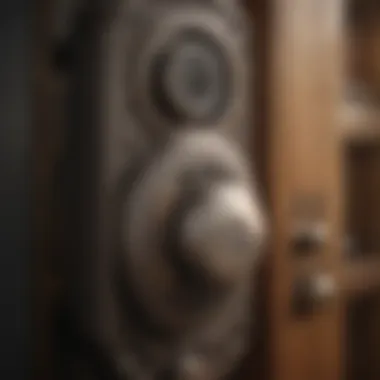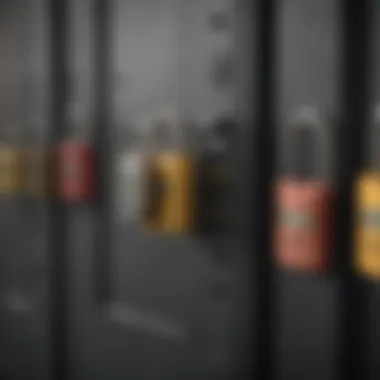The Role of Padlocks and Keys in Modern Security Solutions


Intro
Overview of Topic
Understanding the significance of padlocks and keys in security solutions is crucial, especially for homeowners and individuals focused on securing their spaces. Both items provide a straightforward and practical method of keeping possessions and areas safe. Historically, these mechanisms have evolved from rudimentary designs to sophisticated systems. The importance of this topic lies in its implications for personal and commercial security.
Throughout history, the need for reliable security has driven the development of various locking mechanisms. Padlocks and keys have adapted not only in terms of material but also in design and technology. Today, they remain essential tools in safeguarding assets, evolving alongside advancements in security engineering. In an age where digital alternatives are becoming more prevalent, understanding the traditional elements of security ensures a balanced perspective.
Common Challenges and Solutions
Many homeowners face several issues related to security with padlocks and keys. Common problems include:
- Misplaced keys.
- Faulty padlock mechanisms.
- Lack of compatibility among different keys and locks.
- Inadequate knowledge of high-security options.
Some possible solutions to these challenges include:
- Implement a key management system - Use a designated place for all keys, ensuring they are not misplaced.
- Regular maintenance - Inspect padlocks and replace flawed codes or faulty clasps.
- Upgrading systems - Investigate high-security options in lock systems that offer better protection.
- Education - Seek information regarding modern padlock technologies.
These strategies help prevent mishaps and confusion regarding home security.
Product Recommendations
When considering padlocks and keys, various high-quality options are accessible in the market. Brands worth noting include:
- Master Lock - Renowned for their durable, weather-resistant designs. The combination options simplify use and enhance security.
- ABUS – Known for producing heavy-duty equipment, particularly suitable for commercial properties.
- Kwikset - Offers smart locks that merge traditional key operations with modern technology.
When selecting a product, assess benefits such as:
- Weather endurance.
- Duration of battery life (in smart locks).
- Flexibility of use (as in keyed versus keyless options).
Each brand has distinct features suited for various needs.
Step-by-Step Guides
How to Secure Your Home with Padlocks and Keys
- Identify areas that require locking mechanisms (gates, sheds, storage units).
- Choose appropriate padlocks based on the level of security needed. Ensure durability for outdoor use.
- Make clear usage instructions for children and other family members. Ensure everyone knows where keys are kept if not digital.
- Regularly check that locks function correctly.
“Understanding both traditional and modern security solutions will enable informed choices and enhance safety.”
For further reading, explore articles on Wikipedia, insightful posts on Britannica, or enlightening discussions on Reddit and Facebook.
The Historical Context of Padlocks and Keys
Understanding the historical context of padlocks and keys is essential for recognizing their prominence in modern security solutions. These tools have evolved remarkably from their rudimentary beginnings to the advanced technologies we use today. Their development mirrors societal changes in terms of security needs and technological advancements. Throughout time, padlocks and keys have provided not just physical security, but also a source of cultural identity and technological innovation inherent within different civilizations.
Early Innovations in Locking Mechanisms
The earliest locking mechanisms date back to ancient civilizations. One of the earliest forms of a padlock originated around 500 BC in Egypt, made from wood and tethered to gates. Similarly, the Ancient Romans developed a more refined model. They crafted locks from bronze and introduced the concept of the key, which was a very basic design made from iron or bronze. These inventions laid the groundwork for countless innovations that followed.
Several standout discoveries shaped the evolution of locking systems. For instance, the introduction of multiple locks, which began in China, significantly increased security. Various sizes and intricate designs encouraged a level of personalization that offered unique challenges for opening them. It's important to understand that as societies advanced, their security mechanisms, like the ones provided by padlocks, had to keep pace.
The development of the key itself played a critical role too. Early keys were not only tools but symbols of status, showcasing wealth and sophistication. Each innovation reflected an increasing knowledge of metalwork and design, paving the way for future advancements in the security of homes and assets.
Cultural Significance Across Civilizations
Padlocks and keys have transcended their functional purposes and emerged as objects of cultural significance across various societies. In ancient Rome, specific locks were gifted to showcase trust and strengthen relationships. They held symbolic value—the act of gifting a lock and key signified confidence in one another, essentially facilitating mutual protection.
In medieval Europe, locks and keys became integral to feudal systems, marking property ownership and safeguarding treasures. Used also to denote authority, they became a first line of defense for aristocrats' castles and grand homes. Many households had intricate mechanisms to secure valuables and secrets.


In contemporary cultures, they often appear in art and literature. Their portrayal signifies themes of dependence and trust, serving as metaphorical devices to express the need for security. In essence, the cultural depths of locks and keys extend far beyond physical security—a blend of trust, tradition, and authority paved their way through time.
Through this journey, one begins to appreciate the significance of padlocks and keys; they are artifacts of human history illustrating the core desire for safety and the protection of one's belongings. As we look into their designs and meanings, we understand that their relevance in security solutions today is a direct reflection of their storied past.
Fundamentals of Padlocks
Padlocks are a crucial element in the landscape of physical security. They offer a simple yet effective solution to securing personal belongings and property. The fundamentals of padlocks include their types, construction materials, and common vulnerabilities which contribute significantly to their functionality and reliability.
Types of Padlocks Available
Padlocks vary widely in design and use cases. Understanding these variations can help in choosing the right padlock for specific security needs.
Combination Padlocks
Combination padlocks utilize a series of numbers to open. This aspect allows for increased flexibility since there is no need for a physical key. Their main characteristic lies in the ability to set and reset the combination, promoting security without the risk of losing a key.
One unique feature of combination padlocks is their key-less design, which appeals to a wide audience looking for convenient security. A disadvantage, however, can be forgetting the combination, rendering the lock unusable.
Keyed Padlocks
Keyed padlocks rely on a specific key to unlock. Their traditional mechanism is easily understood and commonplace. Their key feature is the physical key which can guarantee individual access control, making them still popular today.
They can be advantageous for individuals preferring a straightforward unlocking method. The down side is that if one loses the key, accessing the lock becomes quite challenging.
Smart Padlocks
Smart padlocks represent a growing trend in security technology. They often connect to smartphones via Bluetooth or Wi-Fi, enabling easier access and remote management. This tech-savvy feature promotes greater accessibility without traditional locks and keys.
Their advantage is immediate notifications of unauthorized access attempts, providing insight into your security status. However, reliance on technology also introduces vulnerabilities, such as susceptibility to hacking.
Materials Used in Padlock Construction
Padlocks are constructed using various materials that influence their durability and resistance to manipulation. Steel, brass, and reinforced plastic are some common options employed. Steel models are known for weather resistance and physical strength while brass models often provide a balance of aesthetic appeal and sturdiness. Understanding material strengths and weaknesses can inform the choice of padlock for trustworthy protection.
Common Vulnerabilities in Padlocks
Even with a robust design, padlocks can present vulnerabilities. Methods such as picking, forced entry, and shimming can compromise secured objects. Specific factors, including the design of the lock and the location in which it is used, influence these vulnerabilities. Ensuring to choose a padlock with appropriate security ratings can mitigate some of these risks.
The Mechanics of Keys
The mechanisms of keys serve as a crucial pillar in understanding the overall security solutions provided by padlocks and locks. The effective function and design of various key types significantly influence the efficiency of security systems. Understanding the differentiations among key types can guide users towards more informed decisions about safeguarding their belongings.
Key Types and Their Applications
Bitting Keys
Bitting keys feature a unique design characterized by cuts or notches along their shafts, allowing them to engage specific pins within a lock. This is essential for the lock to operate correctly ensuring that only the designated key works for a given lock. One of the primary reasons for the popularity of bitting keys is their straightforward design making them suitable for residential security applications. Their relative simplicity is advantageous as it makes key duplication easier. However, this simplicity can be seen as a disadvantage; unauthorized copies can be created easily if one mishandles the original.
Dimple Keys
Dimple keys bring a different dynamic to the locking mechanism, having holes instead of notches, which makes them significantly more complex. This design increases the security field, as dimple keys are harder to duplicate without specialized equipment. Users appreciate dimple keys for their higher susceptibility to manipulation compared to traditional keys. This qualitative shift means they enhance the safety aspect, especially in commercial settings, despite the cons often arising from this—for instance, they can be more burdensome to maintain than standard bitting keys.
Electronic Keys
Electronic keys actually represent the modern evolution of security mechanisms which combines sophisticated technology with the simplicity of key usage. They can come in various formats including key fobs and smart card systems. Their importance lies in their centralized control, enabling users extensive security management options and access logs. The attraction of electronic keys lies in their ability to bolster security while offering convenience. Nevertheless, they often need more maintenance than traditional keys and could be vulnerable to hacking or malfunction should the electronic infrastructure be compromised.
Key Duplication and Security
Key duplication raises profound concerns and considerations when ownership of a key is shared outside the home. While duplication is usually a simple and efficient process, one must meticulously select the destinations for key duplication to ensure confidentiality. Neglecting this could allow unauthorised individuals access, thus exacerbating security issues. Keys, if not monitored for duplication, can effectively nullify security efforts originally intended.


Maintenance and Care of Keys
Routine care and maintenance of both pads and locks is vital to maintain their longevity and effectiveness. Regular checks can help alert owners when keys exhibit wear signs, showing reduced performance and potentially leading to inconvenient scenarios where accessing secured areas becomes cumbersome. Proper tracking and storing of keys can also prevent misplacement or theft. Users must also note the future importance of how security can evolve; while more advanced keys come, preserving traditional keys will always have its place in personal and commercial security frameworks.
Applications in Personal Security
The applications of padlocks and keys in personal security cannot be overstated. They provide physical barriers that can be crucial for protecting homes and belongings. Understanding the intricacies of these locking mechanisms allows homeowners to make informed decisions about safeguarding their properties.
Padlocks and keys serve distinctive functions that cater to the varying security needs of individuals. An important aspect of this security is that these devices often act as the first line of defense against trespassers or unwarranted intrusion. The peace of mind that comes from knowing a reliable mechanism exists is significant; it helps in mitigating risks and potential threats to personal safety.
Residential Security Solutions
Residential security solutions play a critical role in ensuring that personal residences are safe. They encompass a range of features—from simple locks on doors to more complex locking systems integrated with alarms or smart technology.
- Types of Locks: Different environments require different types of locks. Deadbolts, knob locks, and smart locks offer varying degrees of security. Deadbolts are often favored for their robustness and resistance to forced entry, while smart locks can provide keyless access, making it easier for homeowners to grant entry remotely.
- Installation Considerations: Security begins at the point of installation. The correct positioning of locks on doors and windows is vital to maximize security. Poorly installed locks may offer a false sense of security and are more vulnerable to exploitation.
- Grouping Locks for Effectiveness: For enhanced security, grouping locks can be beneficial. For instance, using a high-security padlock on a gate combined with a thumb-turn deadbolt on the main door yields layered protection, making unauthorized entry more difficult.
- Privacy Locks: For bathrooms or bedrooms, privacy locks offer not just security but also peace of mind. Consideration for privacy speaks of harmonic personal space while maintaining safety.
In summary, effective residential security relies heavily on the thoughtful selection and installation of padlocks and locking mechanisms. A well-secured home goes a long way in adding a protective layer that guards against potential threats and provides a safe haven for you and your family.
Portable Security Options
With the growing need for on-the-go security, portable options involving padlocks have gained attention. Their practicality makes them ideal for various scenarios.
- Travel Locks: When traveling, using padlocks on luggage is crucial for protecting personal belongings. It deters tampering and signals a degree of security around one's possessions.
- Bicycle Locks: Bicycles are prime targets for theft. U-locks or chain locks must provide robust protection, as many thieves specialize in bypassing lesser quality options. Some portable locks have additional features like alarms or integrated GPS for tracking.
- Portable Safe Locks: For individuals wanting to secure items without an active installation, portable safes equipped with combination locks offer a reasonable solution. This has become popular for outdoor activities like camping or road trips.
- On-the-Go Personal Security Devices: There are also personal safety devices that temporarily secure valuable items in hotels or other public places. These lockable pouches can safeguard essential documents or gadgets, ensuring they remain under lock and key, literally.
Portable security unlocks potential safety solutions for those frequently on the move. An understanding of available portable padlocks gives both practicality and peace of mind.
In sum, applications in personal security underscore the foundational role that padlocks and keys play, enhancing physical safety in various environments—be it at home, while traveling, or engaging in leisure activities.
Commercial Uses of Padlocks and Keys
The role of padlocks and keys in commercial contexts is crucial. Security is a primary concern for businesses. Ensuring the safety of assets and sensitive information can hinge on proper locking mechanisms. Padlocks, when utilized effectively, can provide a reliable and straightforward solution for protecting valuable items in various environments. Their ability to offer both physical security and ease of access means they remain a frequent choice in various sectors, including retail, manufacturing, and logistics.
Securing Assets in Business Environments
In businesses, padlocks can be used in numerous ways. They serve to secure everything from storage units and equipment to vehicles and containers, playing an integral role in the overall security strategy.
Some key benefits include:
- Deterrence: Even basic padlocks can act as a visible deterrent against theft; exposing assets behind a locked case sends a message that protection is in place.
- Access Control: Especially for large organizations, specifying which employees have access to certain areas is easily managed through secured equipment.
- Versatility: The varying types of padlocks available means businesses can select suitable locks tailored to different security needs.
- Low Technology Risk: Unlike electronic locking systems, traditional padlocks often pose lower risks in terms of cyber threats or software malfunctions.
These factors combine to make padlocks a trusted choice among business professionals. Many establishments rely on them routinely to secure their investments.
Lock Management Systems in Corporations
Corporations often require systematic management of their locks and keys. This saves time and increases efficiency. A Lock Management System can further protect an organization's assets by ensuring a durable and stable approach to security.
Key features of such systems include:
- Centralized Control: Effective management allows for a structured overview of all locks and keys in use. It's critical for accountability.
- Automated Key Management: Advanced management solutions include digital records, enabling the quick retrieval or blocking of keys if necessary.
- Maintenance Scheduling: Proper record keeping helps companies understand the lifespan of their locks and plan timely replacements.
A comprehensive lock management system enhances not just security but also promotes operational efficiency across various divisions.
Transitioning towards lock management systems introduces not only a layer of accountability but also a structured resolution to control over access to sensitive facilities. As corporations explore the possibilities, adaptation is led proactively towards defending their physical assets while ensuring the integrity services provided.
The Shift to Digital Security Solutions
The transition from traditional padlocks and keys to digital security systems marks a significant chapter in the narrative of personal and commercial safety. This shift responds to a notable appeal for convenience and advanced features in our ever-increasingly connected society. Digital security solutions represent not just a replacement, but an evolution in how security is conceptualized, effectively marrying technology with practical home and business requirements.
Emergence of Electronic Locks


Electronic locks signify a departure from the mechanical nature of padlocks. These locks often utilise keypads, biometric scanners, or mobile app-based systems to access locked spaces. They provide an important benefit; frequent interactions with the lock mechanism can erode a mechanical lock's integrity over time. Electronic alternatives not only tend to last longer forgiveness, they often have customizable access restrictions. This capability is particularly valuable in scenarios requiring varying levels of access—for instance, granting temporary entry to delivery personnel. Moreover, remote lock management can enhance security by allowing for real-time locking and unlocking.
Integration with Smart Home Systems
The integration of electronic locks with smart home ecosystems creates amazing opportunities for modern security. One popular leverage is the ability to connect locks with smartphones and other devices. This feature allows users to control their locks from anywhere, ensuring that connections are elastic and reliable. Furthermore, they can be linked to home security cameras, alerting homeowners to any breaches instantly. By marrying padlocks with the internet of things, homeowners access numerous security benefits tailored specifically for their environment.
Changing security measures should involve understanding the integration into an overall system—this means considering energy consumption, potential for hacking, and hardware compatibility if one hopes to relish its full benefits. A thorough understanding here aids in making an educated choice accordingly.
Comparative Analysis of Traditional vs.
Digital Security
When one evaluates traditional padlocks and digital security, one must assess several factors:
- User convenience: Digital locks often enable keyless entry, offering expedited access operations. Traditional locks require physical keys, which may get lost and complicate access.
- Security features: While traditional locks serve basic functions of securing property, digital locks can grant unique and advanced security features such as alerts on tampering and unauthorized attempts.
- Maintenance and vulnerability: Electronic locks require electrical power, posing risks during outages. Conversely, mechanical locks may wear out with use but do not depend on power durability.
Choosing between traditional and digital methods is subjective and should encompass personal comfort levels around technology and trust. Maintaining informed vigilance remains the guiding principle, ensuring safeguards align with specific individual lifestyles.
The progression of security technology is not diminishing the inherent value of traditional mechanisms, rather, it highlights a fundamental transformation paving new pathways forward.
Undoubtedly, the shift to digital security solutions signifies essential developments echoing throughout households and businesses alike. In adapting current strategies to emerging technologies, individuals take actionable steps toward a safer, more secure future.
Future Trends in Security Technologies
The landscape of security technology is shifting rapidly. Traditional methods using padlocks and keys face new challenges posed by advancing digital offerings. Understanding future trends in security technologies helps secure our homes and businesses more effectively. It shapes how we perceive safety and accessibility in the modern world.
Advancements in Lock Technology
Recent developments in lock technology mark significant shifts in how we manage security. More robust materials and innovative designs enhance physical locks. For instance, materials like high-strength steel are becoming common, which increases resistance to tampering. Additionally, advancing technologies allow users to configure their locks for higher security through changing combinations or patterns easily.
Furthermore, manufacturers are integrating biometric features. By employing fingerprint and facial recognition, these locks bring a higher security level, making unauthorized access difficult.
– Keyless entry systems are on the rise. They simplify access, especially in high-traffic and rental situations. – Smart locks hold promise. They can be locked and unlocked using a smartphone, monitoring who enters and exits.
With consumer focus on convenience coupled with security, these advancements cater to expectations efficiently and effectively.
Artificial Intelligence in Security Systems
In recent years, artificial intelligence has begun a noteworthy partnering in the security domain. AI enhances several functions related to padlocks and keys apart from physical security measures. It introduces data-driven approaches to vulnerabilities by evaluating access patterns and identifying unusual activities.
Using AI systems leads to improved smart locks which gather usage data. This data, in return, offers critical insights on user habits and device status. Could specialists soon forecast and prevent security breaches before they occur? The potential for AI in security continues to expand
Artificial Intelligence can learn patterns, predict risks, and adapt security measures nonstop.
Organizations can bolster their systems using AI. It can automate notifications, enabling instant alerts on unauthorized access. Combining AI with existing security frameworks leads to a higher level of clarity and effectiveness.
The implications for homeowners and businesses are immense. Dive deeper into these technologies, starting with your uplifting journey through how you decide to fortify your surroundings. Understanding these future trends not only maximizes security but integrates technology seamlessly into our daily lives.
Explore more about these advancements at Wikipedia or read additional motivations on Reddit.
Epilogue
In closing, the exploration of padlocks and keys reveals their critical role in security systems, addressing concerns that extend beyond mere functionality. Understanding their evolution helps discern their importance today, serving not only as physical barriers but also as symbols of safety and trust.
Summarizing the Role of Padlocks and Keys
Padlocks and keys provide more than just mechanisms to secure personal property or access points. Their fundamental role encompasses both practicality and peace of mind for homeowners and families. Here are the essential aspects to consider:
- Historical significance: The long-standing use of these devices highlights their proven reliability in protecting assets.
- Diversity in Options: The variety in padlock types caters to different security needs. Individuals can choose from combination locks, keyed entries, or modern digital alternatives to guard properties.
- Textual Consequence of Advanced Technologies: The usability of electronic locks represents a growing shift, enhancing traditional methods.
Harnessing the blend of traditional and digital allows homeowners to optimize security solutions for their needs.
The careful selection and maintenance of padlocks and keys are paramount. Security relies heavily on choosing the right one for the application, ensuring high-security types where needed, and properly maintaining them. Making informed choices helps to establish a robust security foundation, ultimately ensuring peace of mind.
Overall, padlocks and keys represent a fascinating intersection of history, function, and modern-day implications, enhancing the lives of house owners and reinforcing the importance of security in daily routines. The journey through their evolution outlines how integral they continue to be within both personal and public security realms.







